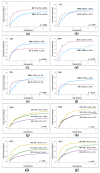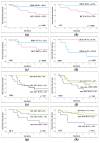Infections with Staphylococcus spp. in Children Undergoing Anticancer Therapy or Haematopoietic Cell Transplantation: A Nationwide Multicentre Study
- PMID: 40806822
- PMCID: PMC12346928
- DOI: 10.3390/jcm14155200
Infections with Staphylococcus spp. in Children Undergoing Anticancer Therapy or Haematopoietic Cell Transplantation: A Nationwide Multicentre Study
Abstract
Background: Staphylococcus spp. represent the most prevalent Gram-positive organisms in children with malignancies or undergoing haematopoietic cell transplantation (HCT), contributing to significant morbidity and mortality. This study aimed to assess the epidemiology, risk factors, treatment strategies, and outcomes of staphylococcal infections (SIs) in paediatric haemato-oncology (PHO) and HCT patients in Poland over a 12-year period. Methods: A retrospective, multicentre study was conducted across 17 paediatric oncology centres in Poland. The clinical and microbiological data of patients under the age of 18, diagnosed with malignancies or post-HCT, were analysed for confirmed SI between 2012 and 2023. The variables assessed included demographics, underlying conditions, infection type and source, antimicrobial susceptibility, treatment, and 30-day infection-free survival. Results: Among 1725 patients with SI, 1433 were PHO and 292 were HCT patients. The cumulative incidence of SI was 12.7% in PHO and 14.3% in HCT patients (p = 0.008). The 30-day survival rate was significantly higher in PHO compared to HCT patients (98.4% vs. 93.2%, p < 0.001). Most deaths were caused by S. epidermidis, S. haemolyticus, and S. hominis, predominantly involving methicillin-resistant coagulase-negative Staphylococci (MRCNS). Multivariate Cox regression identified undergoing HCT (HR = 3.0, 95% CI: 1.6-5.6, p < 0.001) and treatment of infection > 10 days (HR = 2.0, 95% CI: 1.1-3.6, p = 0.019) as independent risk factors for mortality. Conclusions: Staphylococcal infections pose a significant challenge in paediatric oncology and transplant populations. Optimising prevention, diagnostics, and antimicrobial therapy is crucial for improving outcomes in these high-risk groups.
Keywords: Staphylococcus; bacteraemia; haematopoietic cell transplantation; infection; leukaemia; oncology; paediatric malignancy.
Conflict of interest statement
The authors have no conflict of interest to disclose.
Figures


Similar articles
-
High-dose chemotherapy and autologous haematopoietic stem cell rescue for children with high-risk neuroblastoma.Cochrane Database Syst Rev. 2015 Oct 5;2015(10):CD006301. doi: 10.1002/14651858.CD006301.pub4. Cochrane Database Syst Rev. 2015. PMID: 26436598 Free PMC article.
-
Static Versus Articulating Spacer: Does Infectious Pathogen Type Affect Treatment Success?Clin Orthop Relat Res. 2024 Oct 1;482(10):1850-1855. doi: 10.1097/CORR.0000000000003075. Epub 2024 Apr 25. Clin Orthop Relat Res. 2024. PMID: 38662933
-
High-dose chemotherapy and autologous haematopoietic stem cell rescue for children with high-risk neuroblastoma.Cochrane Database Syst Rev. 2013 Aug 22;(8):CD006301. doi: 10.1002/14651858.CD006301.pub3. Cochrane Database Syst Rev. 2013. Update in: Cochrane Database Syst Rev. 2015 Oct 05;(10):CD006301. doi: 10.1002/14651858.CD006301.pub4. PMID: 23970444 Updated.
-
Bone marrow versus peripheral blood allogeneic haematopoietic stem cell transplantation for haematological malignancies in adults.Cochrane Database Syst Rev. 2014 Apr 20;2014(4):CD010189. doi: 10.1002/14651858.CD010189.pub2. Cochrane Database Syst Rev. 2014. Update in: Cochrane Database Syst Rev. 2024 Nov 7;11:CD010189. doi: 10.1002/14651858.CD010189.pub3. PMID: 24748537 Free PMC article. Updated.
-
Sex and gender as predictors for allograft and patient-relevant outcomes after kidney transplantation.Cochrane Database Syst Rev. 2024 Dec 19;12(12):CD014966. doi: 10.1002/14651858.CD014966.pub2. Cochrane Database Syst Rev. 2024. PMID: 39698949
References
-
- Styczynski J., Czyzewski K., Wysocki M., Gryniewicz-Kwiatkowska O., Kolodziejczyk-Gietka A., Salamonowicz M., Hutnik L., Zajac-Spychala O., Zaucha-Prazmo A., Chelmecka-Wiktorczyk L., et al. Increased Risk of Infections and Infection-Related Mortality in Children Undergoing Haematopoietic Stem Cell Transplantation Compared to Conventional Anticancer Therapy: A Multicentre Nationwide Study. Clin. Microbiol. Infect. Off. Publ. Eur. Soc. Clin. Microbiol. Infect. Dis. 2016;22 doi: 10.1016/j.cmi.2015.10.017. - DOI - PubMed
-
- Al-Mulla N.A., Taj-Aldeen S.J., El Shafie S., Janahi M., Al-Nasser A.A., Chandra P. Bacterial Bloodstream Infections and Antimicrobial Susceptibility Pattern in Pediatric Hematology/Oncology Patients after Anticancer Chemotherapy. Infect. Drug Resist. 2014;7:289–299. doi: 10.2147/IDR.S70486. - DOI - PMC - PubMed
-
- Zając-Spychała O., Wachowiak J., Pieczonka A., Siewiera K., Frączkiewicz J., Kałwak K., Gorczyńska E., Chybicka A., Czyżewski K., Jachna-Sawicka K., et al. Bacterial Infections in Pediatric Hematopoietic Stem Cell Transplantation Recipients: Incidence, Epidemiology, and Spectrum of Pathogens: Report of the Polish Pediatric Group for Hematopoietic Stem Cell Transplantation. Transpl. Infect. Dis. Off. J. Transplant. Soc. 2016;18:690–698. doi: 10.1111/tid.12581. - DOI - PubMed
-
- Demiselle J., Meyer P., Lavigne T., Kaurin J., Merdji H., Schenck M., Studer A., Janssen-Langenstein R., Helms J., Hoellinger B., et al. Staphylococcus Epidermidis Bloodstream Infections Are a Cause of Septic Shock in Intensive Care Unit Patients. Int. J. Infect. Dis. 2023;135:45–48. doi: 10.1016/j.ijid.2023.07.014. - DOI - PubMed
Grants and funding
LinkOut - more resources
Full Text Sources
Miscellaneous

